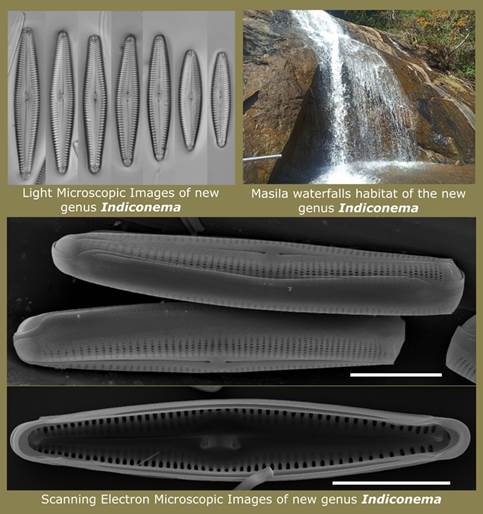Researchers have discovered a new genus of the Gomphonemoid diatom found in the clean water river of the Eastern Ghats. The genus which has an interesting suite of features, distinguishing it from the other members in the group Gomphonemoid in terms of valve symmetry and other certain valve features, has been named Indiconema to value its restricted distribution in the country. The research underlines the importance of diatoms in shaping the biodiversity of India’s diverse landscapes.
Diatoms are microscopic algae that play a crucial role in our everyday lives by producing 25 per cent of global oxygen, approximately every fourth breath of oxygen we inhale. They serve as a base of the aquatic food chain. Due to their sensitivity towards any water chemistry changes, they are excellent indicators of aquatic health.
Diatoms are the first recorded microorganisms in India, with Ehrenberg’s first report dating back to 1845 in his voluminous publication Mikrogeologie. Since then, several studies in India have recorded diatoms from freshwater and marine environments. A rough estimate counts that there are nearly 6,500 diatom taxa, of which 30 per cent are endemic (restricted to a particular region) to India, suggesting India’s unique biodiversity. Further, diverse biogeographic zones support various species with habitat diversity ranging from freshwater to marine, sea level to high mountains, and alkaline lakes to acidic swamps. Peninsular India includes Eastern and Western Ghats and has distinct physiographic, edaphic, and climatic gradients that cherish a wide array of habitats with unique geographic positions and supporting unique sets of diatoms.
Indiconema discovered by scientists of Agharkar Research Institute (ARI), Pune, an autonomous institute of Department of Science and Technology, differs in having a pore field at both the head and foot pole rather than having only at the foot pole.
The evolution of monsoons structured the rainforest biome across the Indian Peninsula and the associated varying wetness, which has a direct role in shaping the diatom flora.
The research published in the journal Phycologia, reports one species of Indiconema from the Eastern Ghats and another from the Western Ghats. A similar pattern of sharing endemic elements between two mountain systems has been observed for other endemic-rich groups, such as reptiles.
Additionally, based on the morphological features of this group, the researchers have suggested that Indiconema is sister to Afrocymbella, a genus endemic to East Africa. Early studies noted that similarities between Gomphonema species from India and those from East Africa and Madagascar are supported by the current study association. The discovery supported by the erstwhile SERB, now ANRF underscores the importance of ongoing research in unravelling the mysteries of diatom biogeography and their role in shaping the biodiversity of India’s diverse landscapes.
Publication Link: https://doi.org/10.1080/00318884.2023.2268381

 Matribhumi Samachar English
Matribhumi Samachar English


